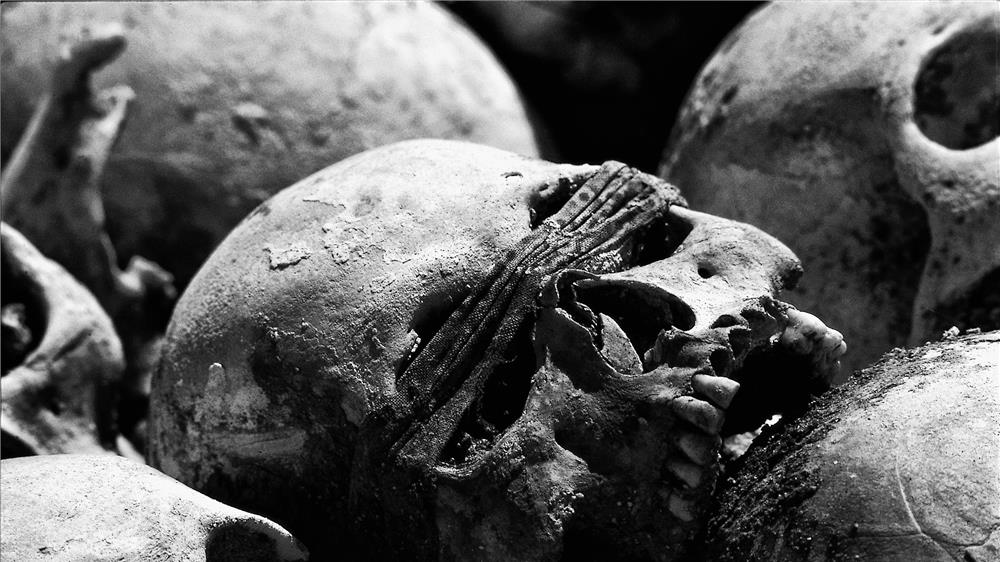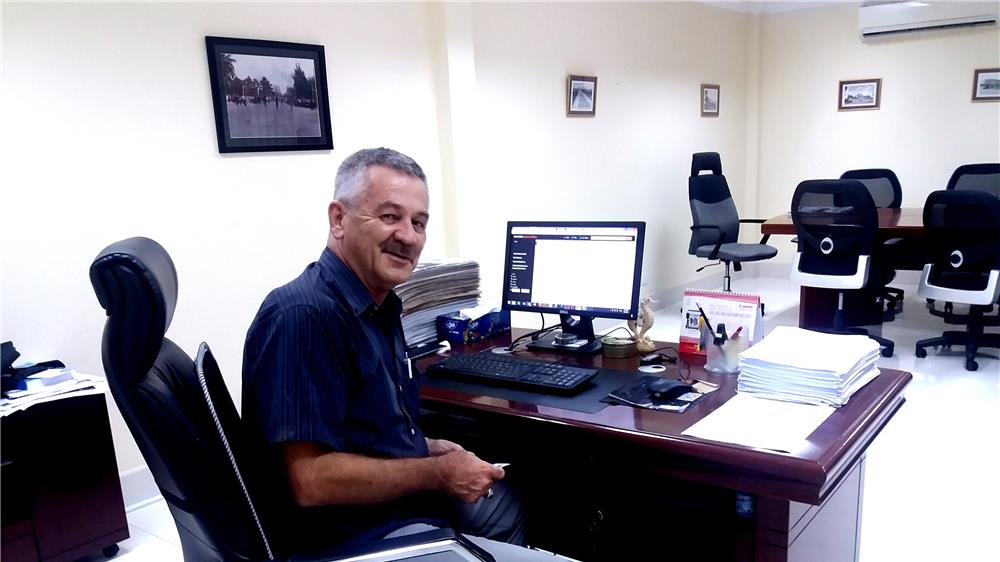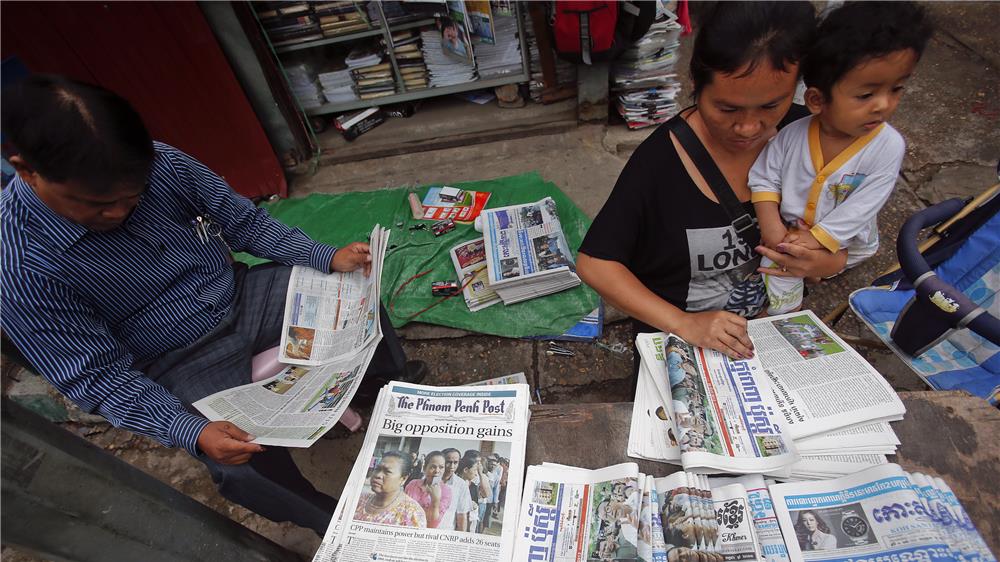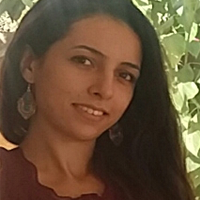رغم دخول مملكة كمبوديا عهد الانفتاح في الألفية الثانية، ومصادقتها على كثير من بنود الحقوق والحريات، التي تبدو جلية -على وجه الخصوص- في عودة الإعلام إلى مكانته بعدما حُكم على كل وسائله بالغلق في عهد الخمير الحمر، فإن صحفيين كثيرين هنا (في كمبوديا) يرون أن الإعلام لم يتعد بعدُ عتبة سلم التغيير، وأن كل المخاض الذي شهده في العقد الأخير لم ينتج عنه سوى مولود غير مكتمل النمو.
أصل الحكاية
قبل أربعة عقود من الآن، وبعد خروج كمبوديا لتوها من عقود الاحتلال الفرنسي وما تلاها من حروب أهلية، أفاقت ذات يوم على خبر نجاح بول بوت كزعيم وأخ ورفيق؛ الرجل الذي وعد بقلب البلاد رأسا على عقب لصالح الفقراء. وقد وفى بالجزء المتعلق بتحويل البلاد إلى مزارع شاسعة، لكنها لم تكن لصالح الفقراء، بل تم استعمالهم كعبيد، وتحولت المملكة العتيقة في أقل من أربع سنوات إلى محرقة راح ضحيتها ثلث الشعب على الأقل، ولم يُسمع عنهم أي خبر إلا بعد رحيل النظام.

لا يمكن لحدث كهذا أن يغيب عن ذهن أي مواطن كمبودي عادي، ذاق هو أو واحد من أفراد أسرته على الأقل؛ ويلات الخمير الحمر. فما بالك بمواطن"غير عادي"، اختار نظام الزعيم الجديد أن يمحو أثره، قبل أن تصل أحوال البلاد إلى آذان الشعوب المتعاطفة طوعيا مع القضايا الإنسانية حول العالم، فأعدم حتى آخر يوم من حكمه كل المفكرين والمثقفين والإعلاميين، واعتبرهم خونة وفتانين.
مواقف
عند وصولي العاصمة فنوم بنه قبل بضعة أشهر ولقائي بعض الزملاء، تعرفت إلى نازي سليس، وهو شاب كمبودي من الأقلية التشامية المسلمة، لم يعايش مجازر الخمير الحمر، لكنه يقول إن محاكمتهم مطلع الألفية الثانية لم تكن نهاية القصة.
يملك نازي سليس اليوم قناة على اليوتيوب، وبرنامجا حواريا مباشرا يبث كل خميس يتابعه مئات من الشباب المسلم، كما يعمل في الميدان الخيري باسم جمعيته "المركز الإعلامي لمسلمي كمبوديا"، وقد أخبرني أنه اختار العمل بشكل مستقل بعد تجربة شخصية محبطة.. "درست الإعلام في الكلية وكان حلمي دوما أن أقدم تقارير ميدانية من عمق كبوتشام، حيث ولدت وترعرعت، لكن أحلامي لم تعرف النور إلا لفترة، فقد أغلقوا الإذاعة ومنعوني من مزاولة العمل الميداني".
كان سليس يدير إذاعة "صوت تشام" (Voice of Cham)، لكنها أغلقت بسبب تقرير ميداني أعده حول سبب توقف أعمال بناء مسجد آل سركال في العاصمة فنوم بنه رغم الدعم المادي الذي تلقاه المعنيون بالأمر.
في عام 2016، سجلت كل وسائل الإعلام الأجنبية حادثة مروعة لمقتل المعارض كيم لاي بالرصاص الحي، بينما تجاهل الأمر برمته الإعلام الكمبودي.

مستجدات
من أجل إعداد هذا التقرير، اتصلت بالزميل شكري زهرون الذي كان يعمل إلى وقت قريب في جريدة "خمير تايمز" (Khmer Times) ثاني أكثر الجرائد قراءة هنا.
التقينا في مقهى "ليبراري" الكائن بشارع باستور، وعرض عليّ زيارة مدير التحرير بالجريدة صبيحة اليوم التالي، لأنقل إليه أسئلتي مباشرة.. أسئلتي التي لم تكن في الحقيقة سوى سؤال واحد، عن مدى الحرية التي يتمتع بها الصحفيون في كمبوديا.
استقبلني ألان باركهاوس في مكتبه بالطابق الثاني حيث غرفة الأخبار التي يعمل فيها بدوام كامل 12 موظفا، أربعة منهم أجانب.قال لي بعد أن قدم لي كأس ماء بارد "سيغلقون جريدة كمبوديا ديلي قريبا،هل لديك خبر؟ يقولون بسبب عدم تسديدهم للفواتير".. سألته هل الإغلاق بسبب الفواتير فقط؟ فقال"على أية حال نحن نسدد فواتيرنا بانتظام".

وكانت سكرتيرة تحرير صحيفة "كمبوديا ديلي" الأميركية ديبوراكريشر قد أعلنت في وقت سابق أن صحيفتها التي تصدر منذ أكثر من 24 عاما، تواجه أمرا بالغلق بسبب 6.3 ملايين دولار من الضرائب غير المدفوعة.
وبالفعل، نُفِّذ قرار الإغلاق يوم 4 سبتمبر/أيلول 2017 -أي بعد لقائي بمدير تحرير الصحيفة- بحجة عدم قدرتها على تسديد الضرائب.

من ناحية أخرى، صرّح لي المتحدث باسم المجلس الوزاري ساي سيفان هاتفيا بأن حكومته لم تغلق صحيفة كمبوديا ديلي، بل إن مالكها برنارد كريشر هو من أعلن توقيفها لعدم قدرته على تسديد الضرائب.
الصحفي شكري زهرون الذي غادر عمله في جريدة "خمير تايمز" قبل مدة قصيرة بسبب متابعته للدراسات العليا، قال لي ونحن نحتسي شايا تايلنديا في المكتبة، إنأكثر من 15 محطة إذاعية أُغلقت في جميع أنحاء البلاد، إحداها محطة "موها نوكور"التي أجرت بثها لإذاعة "آسيا الحرة" و"صوت أميركا"، وكذلك لحزب الإنقاذ الوطني الكمبودي، وقد أغلقت يوم 21 أغسطس/آب 2017.
يحكي لي: "هذه ليست أولى الحوادث، فسجلّنا ممتلئ جدا.. لديك مثلا في 2014، اعتدى حراس أمن منطقة دون بنه على مراسل "صوت الديمقراطية" لاي ساميان، وقد حاول الإعلام المحلي إخفاء القضية بشتى الطرق كما اعتاد أن يفعل دوما".
قال لي مدير التحرير ألان باركهاوس إن جريدته التي تصدر منذ مطلع 2014 جريدة مستقلة لا تمثل أي جهة، بل تنقل عين الحقيقة، وأكد لي أنه غير واثق من استمرارهم على نفس المنوال، إذ إن هذا الخط -ويقصد الصوت المستقل- لم يؤت أكله في كمبوديا المنغلقة على نفسها للأسف، فجل الحكومات المتعاقبة تمارس سياسات القمع والإقصاء ذاتها ضد الأصوات الحرة.
حاليا لدى كمبوديا أكثر من 300 صحيفة، وإن كان عدد قليل منها ينشر الأخبار الطازجة على صفحاته بشكل يومي. أما الصحف الصادرة باللغة الإنجليزية فهي ثلاث، وتكاد تكون وسائل الإعلام المستقلة الوحيدة، وهي على التوالي من حيث عدد القراء: صحيفة فنوم بنه، صحيفة خمير تايمز، وصحيفة كمبوديا ديلي التي صدر أمر بإغلاقها يوم 4 سبتمبر/أيلول 2017. أما الصحف التي تصدر بانتظام وباللغة الخميرية فهي لا تتجاوز 30صحيفة.
يقول لي الصحفي شكري زهرون عن تلك الصحف إنها أبواق للحكومة.. "لا يوجد عندنا إعلام مستقل، حتى الصحف التي تصدر بالإنجليزية تطبل وتزمر للحكومة كلما سنحت الفرصة". وأكد لي أن تي موهان ناشر "خمير تايمز" تبث عنه في وثائق مسربة هذه السنة؛ أن له علاقات وطيدة مع كبار المسؤولين في الحكومة.
وعن القنوات الفضائية شرح لي زهرون أن الأغلبية الساحقة ملك للدولة، والبقية يسيطر عليها حزب الشعب الكمبودي الحاكم، أو على الأقل شخصيات بارزة منحازة إليه.

مواقف أخرى
التقيت نازي سليس في مناسبة أخرى قبل ثلاثة أشهر، في دعوة وجهها لنا شاب عربي يريد فتح قناة فضائية هنا (لم تفتح حتى كتابة هذا التقرير). وأثناء دردشتنا قال لي إن الشباب الكمبودي مستهلك للفيسبوك بطريقة هستيرية، لهذا اختار أن تكون انطلاقته بعد إغلاق الإذاعة من هذه المنصة، قبل أن ينتقل إلى موقع إلكتروني فعال ثم بعد ذلك إلى قناة على اليوتيوب.
يحكي لي "معظم المواقع مواقع للمعلومات العامة أو للترفيه، إلا أن عددا منها بدأ يسلط الضوء على الأخبار.. نحاول بدورنا نقل الأخبار عبر شاشتنا دون انحياز، فمعظم تلك المواقع الإلكترونية تعتبر منفذا إلى وسائل الإعلام الناطقة بلسان الحكومة".
تشير الأرقام الواردة عن دار الحرية إلى أن 12 صحيفة أوقفت بين عامي 1993 و2014 فقط، وقد صنفت كمبوديا وفقا لمؤشر حرية الصحافة العالمي لعام 2017 في المرتبة 132 من أصل 180 بلدا في العالم.
ومعاقتراب موعد الانتخابات الوطنية المقبلة لعام 2018، يرى كثير من النشطاء على مواقع التواصل الاجتماعي أن الحكومة -التي يمثلها حزب الشعب الكمبودي- تقود حملات غير مباشرة ضد وسائل الإعلام المستقلة التي تجرؤ على انتقادها.
الصحفي شكري زهرون الذي لا يفكر بالعمل مراسلا لأي جهة حكومية بعد تخرجه، يرى أن العمل في صحافة بلده ما زال محفوفا بالمخاطر، وأن الحكومة لا تتغاضى عن اختلاق الذرائع لإسكات الأصوات الحرة.
يحدثني أنه يوم 3 أغسطس/آب الماضي، أمرت وزارة الإعلام مؤسس المركز الإعلامي للمرأة تشيا صن دانيث بوقف إعادة بث الأخبار على إذاعتي "آسيا الحرة" و"صوت أميركا"، مدعية أن كلتا الإذاعتين لم تسجل مكاتبها رسميا في الوزارة بعد.
صور بالأبيض والأسود
بعد مرور ساعة على حديثنا، كان على مدير التحرير باركهاوس أن يعود إلى عمله، خصوصا أني كنت اعتذرت منه مرتين بعد اتفاقنا على موعد للقاء، لكن قبل مغادرتي فتح حاسوبه وبدأ يقرأ علي من مقالاته القديمة، ثم استدار إلى لوحات بالأبيض والأسود معلقة على الحائط خلف كرسي مكتبه، وقال لي"انظري إلى التاريخ أسفل الصور، هل يذكرك بشيء ما؟".
1975، 1976.. ومن لا يتذكر؟
كانت صورا بعدسته الخاصة توثق لسنوات الخمير الحمر.. أطفال يهربون وجنود يطلقون الرصاص!








































